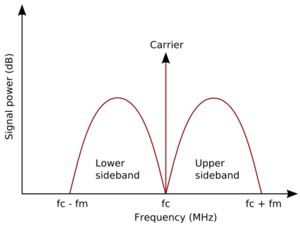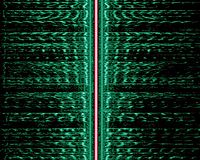
Sideband
Encyclopedia

Radio
Radio is the transmission of signals through free space by modulation of electromagnetic waves with frequencies below those of visible light. Electromagnetic radiation travels by means of oscillating electromagnetic fields that pass through the air and the vacuum of space...
communications, a sideband is a band of frequencies higher than or lower than the carrier frequency
Carrier wave
In telecommunications, a carrier wave or carrier is a waveform that is modulated with an input signal for the purpose of conveying information. This carrier wave is usually a much higher frequency than the input signal...
, containing power as a result of the modulation
Modulation
In electronics and telecommunications, modulation is the process of varying one or more properties of a high-frequency periodic waveform, called the carrier signal, with a modulating signal which typically contains information to be transmitted...
process. The sidebands consist of all the Fourier
Fourier
Fourier most commonly refers to Joseph Fourier , French mathematician and physicist, or the mathematics, physics, and engineering terms named in his honor for his work on the concepts underlying them:In mathematics:...
components of the modulated signal except the carrier. All forms of modulation produce sidebands.
Amplitude modulation
Amplitude modulation
Amplitude modulation is a technique used in electronic communication, most commonly for transmitting information via a radio carrier wave. AM works by varying the strength of the transmitted signal in relation to the information being sent...
of a carrier wave
Carrier wave
In telecommunications, a carrier wave or carrier is a waveform that is modulated with an input signal for the purpose of conveying information. This carrier wave is usually a much higher frequency than the input signal...
normally results in two mirror-image sidebands. The signal components above the carrier frequency constitute the upper sideband (USB), and those below the carrier frequency constitute the lower sideband (LSB). In conventional AM transmission
Transmission (telecommunications)
Transmission, in telecommunications, is the process of sending, propagating and receiving an analogue or digital information signal over a physical point-to-point or point-to-multipoint transmission medium, either wired, optical fiber or wireless...
, the carrier and both sidebands are present, sometimes called double sideband amplitude modulation (DSB-AM).
In some forms of AM, the carrier may be removed, producing double sideband with suppressed carrier (DSB-SC). An example is the stereophonic difference (L-R) information transmitted in stereo FM broadcasting
FM broadcasting
FM broadcasting is a broadcasting technology pioneered by Edwin Howard Armstrong which uses frequency modulation to provide high-fidelity sound over broadcast radio. The term "FM band" describes the "frequency band in which FM is used for broadcasting"...
on a 38 kHz subcarrier
Subcarrier
A subcarrier is a separate analog or digital signal carried on a main radio transmission, which carries extra information such as voice or data. More technically, it is an already-modulated signal, which is then modulated into another signal of higher frequency and bandwidth...
. The receiver locally regenerates the subcarrier by doubling a special 19 kHz pilot tone
Pilot signal
In telecommunications, a pilot is a signal, usually a single frequency, transmitted over a communications system for supervisory, control, equalization, continuity, synchronization, or reference purposes....
, but in other DSB-SC systems, the carrier may be regenerated directly from the sidebands by a Costas loop
Costas loop
A Costas loop is a phase-locked loop used for carrier phase recovery from suppressed-carrier modulation signals, such as from double-sideband suppressed carrier signals. It was invented by John P. Costas at General Electric in the 1950s...
or squaring loop. This is common in digital transmission systems such as BPSK where the signal is continually present.

Television
Television is a telecommunication medium for transmitting and receiving moving images that can be monochrome or colored, with accompanying sound...
broadcasting
Broadcasting
Broadcasting is the distribution of audio and video content to a dispersed audience via any audio visual medium. Receiving parties may include the general public or a relatively large subset of thereof...
, which would otherwise take up an unacceptable amount of bandwidth. Transmission in which only one sideband is transmitted is called single-sideband transmission or SSB. SSB is the predominant voice mode on shortwave radio
Shortwave
Shortwave radio refers to the upper MF and all of the HF portion of the radio spectrum, between 1,800–30,000 kHz. Shortwave radio received its name because the wavelengths in this band are shorter than 200 m which marked the original upper limit of the medium frequency band first used...
other than shortwave broadcasting. Since the sidebands are mirror images, which sideband is used is a matter of convention. In amateur radio
Amateur radio
Amateur radio is the use of designated radio frequency spectrum for purposes of private recreation, non-commercial exchange of messages, wireless experimentation, self-training, and emergency communication...
, LSB is traditionally used below 10 MHz and USB is used above 10 MHz.
In SSB, the carrier is suppressed, significantly reducing the electrical power
Electric power
Electric power is the rate at which electric energy is transferred by an electric circuit. The SI unit of power is the watt.-Circuits:Electric power, like mechanical power, is represented by the letter P in electrical equations...
(by up to 12 dB) without affecting the information in the sideband. This makes for more efficient use of transmitter power and RF bandwidth, but a beat frequency oscillator must be used at the receiver
Receiver (radio)
A radio receiver converts signals from a radio antenna to a usable form. It uses electronic filters to separate a wanted radio frequency signal from all other signals, the electronic amplifier increases the level suitable for further processing, and finally recovers the desired information through...
to reconstitute the carrier
Carrier wave
In telecommunications, a carrier wave or carrier is a waveform that is modulated with an input signal for the purpose of conveying information. This carrier wave is usually a much higher frequency than the input signal...
. Another way to look at an SSB receiver is as an RF-to-audio frequency transposer
Transposition (music)
In music transposition refers to the process, or operation, of moving a collection of notes up or down in pitch by a constant interval.For example, one might transpose an entire piece of music into another key...
: in USB mode, the dial frequency is subtracted from each radio frequency component to produce a corresponding audio component, while in LSB mode each incoming radio frequency component is subtracted from the dial frequency.
Sidebands can also interfere
Interference (communication)
In communications and electronics, especially in telecommunications, interference is anything which alters, modifies, or disrupts a signal as it travels along a channel between a source and a receiver. The term typically refers to the addition of unwanted signals to a useful signal...
with adjacent channel
Adjacent channel
In broadcasting an adjacent channel is an AM, FM, or TV channel that is next to another channel. First-adjacent is immediately next to another channel, second-adjacent is two channels away, and so forth. Information on adjacent channels is used in keeping stations from interfering with one...
s. The part of the sideband that would overlap the neighboring channel must be suppressed by filter
Filter (signal processing)
In signal processing, a filter is a device or process that removes from a signal some unwanted component or feature. Filtering is a class of signal processing, the defining feature of filters being the complete or partial suppression of some aspect of the signal...
s, before or after modulation (often both). In Broadcast band
Broadcast band
A Broadcast band is a segment of the radio spectrum used for broadcasting.-See also:* North American broadcast television frequencies* Dead air* Internet radio* radio networks* Music radio* Old-time radio* Radio astronomy* Radio programming...
frequency modulation
Frequency modulation
In telecommunications and signal processing, frequency modulation conveys information over a carrier wave by varying its instantaneous frequency. This contrasts with amplitude modulation, in which the amplitude of the carrier is varied while its frequency remains constant...
(FM), subcarrier
Subcarrier
A subcarrier is a separate analog or digital signal carried on a main radio transmission, which carries extra information such as voice or data. More technically, it is an already-modulated signal, which is then modulated into another signal of higher frequency and bandwidth...
s above 75 kHz are limited to a small percentage of modulation and are prohibited above 99 kHz altogether to protect the ±75 kHz normal deviation
Deviation
Deviation may refer to:* Deviation , the difference between the value of an observation and the mean of the population in mathematics and statistics** Standard deviation, which is based on the square of the difference...
and ±100 kHz channel
Channel (communications)
In telecommunications and computer networking, a communication channel, or channel, refers either to a physical transmission medium such as a wire, or to a logical connection over a multiplexed medium such as a radio channel...
boundaries. Amateur radio
Amateur radio
Amateur radio is the use of designated radio frequency spectrum for purposes of private recreation, non-commercial exchange of messages, wireless experimentation, self-training, and emergency communication...
and public service FM transmitters generally utilize ±5 kHz deviation.
See also
- Independent sidebandIndependent sidebandIndependent sideband is an AM single sideband mode which is used with some AM radio transmissions. Normally each sideband carries identical information, but ISB modulates two different input signals — one on the upper sideband, the other on the lower sideband...
- Single-sideband modulationSingle-sideband modulationSingle-sideband modulation or Single-sideband suppressed-carrier is a refinement of amplitude modulation that more efficiently uses electrical power and bandwidth....
for more technical information about sideband modulation - Sideband computingSideband computingSideband computing is a general term for an area of computer science that is related to the distributed computing and multiple communication channels....
is a distributed computing method using a separate channel than the main communication channel. - Out-of-bandOut-of-bandThe term out-of-band has different uses in communications and telecommunication. In case of out-of-band control signaling, signaling bits are sent in special order in a dedicated signaling frame...
communications involve a separate channel other than the main communication channel. - Side lobeSide lobeIn antenna engineering, side lobes or sidelobes are the lobes of the far field radiation pattern that are not the main lobe....
- TV transmitter

